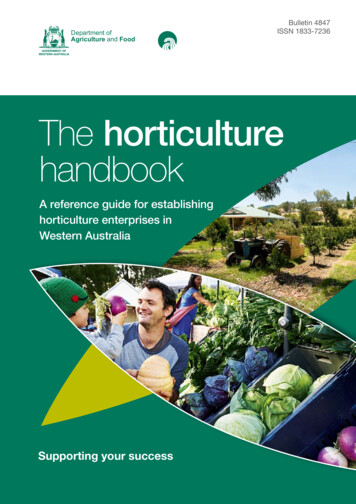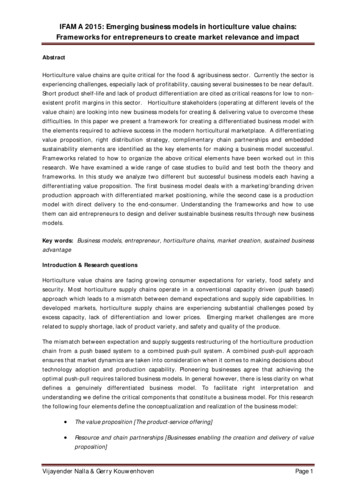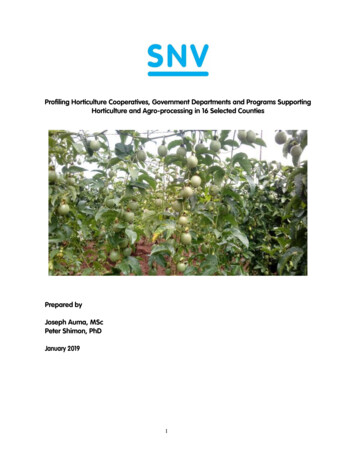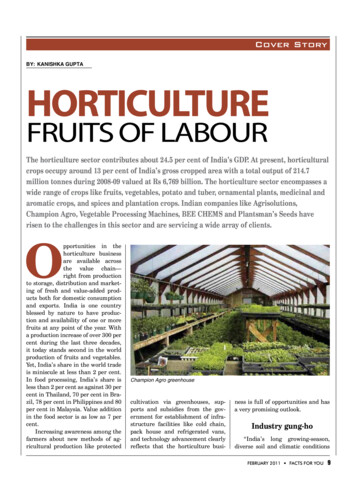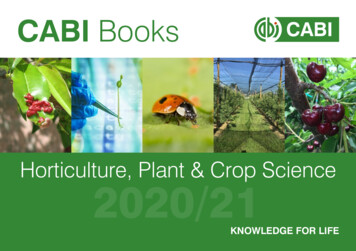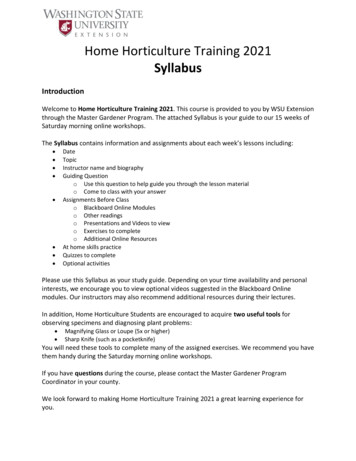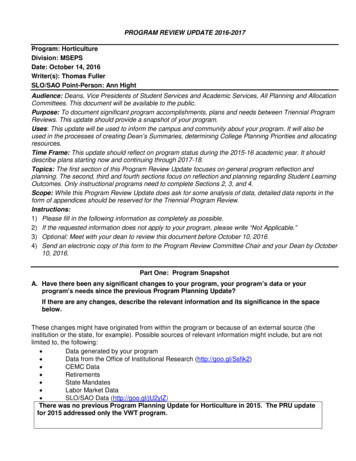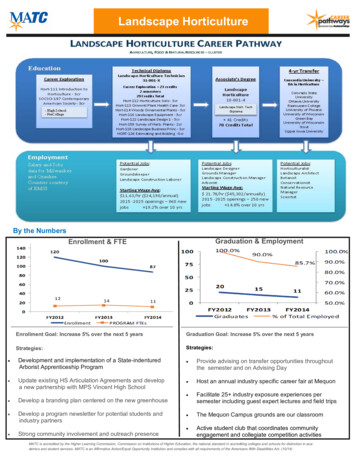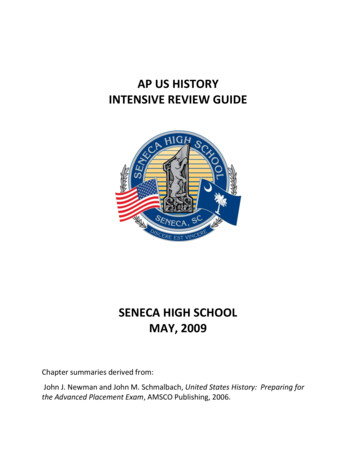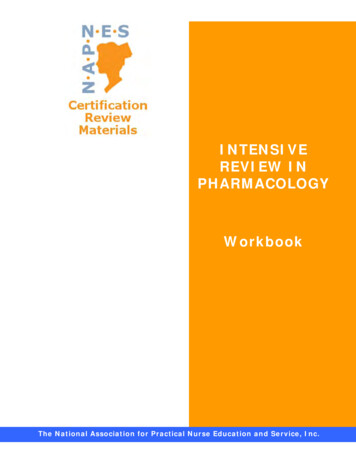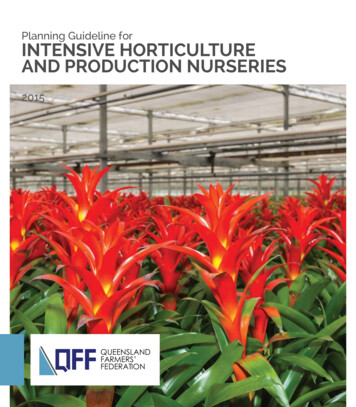
Transcription
Planning Guideline forINTENSIVE HORTICULTUREAND PRODUCTION NURSERIES2015QUEENSLANDFARMERS’FEDERATION
BackgroundThis guideline is to assist local government to properly plan for intensive horticulturedevelopment. It provides information about the industry and suggests planning approaches tobetter accommodate and develop the industry.What are intensive horticulture and production nurseries?Intensive horticulture1 is a premises that is used for the intensive production of plants or plantmaterial on imported media and located within a building or structure or where outdoors,artificial lights or containers are used. The use includes the storage and packing of produceand plants grown on the subject site. Intensive horticulture generally occurs in, or close to,metropolitan centres which provide access to necessary resources, labour and markets.For the purpose of this guideline, intensive horticulture includes production nurseries, lifestyle(amenity) horticulture (i.e. cut flowers, turf and nursery) and intensive fruit and vegetableproduction in controlled environments (e.g. greenhouses or hydroponics). It does not include, forexample, wholesale nurseries.The intensive horticulture industry is characterised by high capital costs to build infrastructure,high labour costs and high value of production relative to the land area. Intensive horticultureutilises temperature-controlled environments to increase productivity and reduce the risk ofweather or other external factors. As such, it mainly focuses on producing high value products fortarget markets.Production nursery is an important component of the intensive horticulture industry. It requiressignificant capital investment in infrastructure specific to the production system. For example,shade houses, green houses, irrigation systems, pesticide storage and handling facilities, twinskin propagation polyhouses, growing media and water storage, and capture of water runoff.Queensland Planning Provisions Version 3.1. Queensland Department of State Development,Infrastructure and Planning, June 2014.1Queensland Farmers’ Federation 2015.Planning Guideline for Intensive Horticultureand Production Nurseries. QFF, Brisbane. Copyright 2015 Queensland Farmers’ FederationThis work is Copyright. Apart from any use aspermitted under the Copyright Act 1968, no partmay be reproduced by any process without writtenpermission from Queensland Farmers’ Federation.Requests and enquiries concerning reproductionand rights should be addressed toQueensland Farmers’ Federation, PO Box 12009Brisbane Qld 4003 or qfarmers@qff.org.au.2
Industry overviewHorticulture (both intensive and extensive types) is Queensland’s largest primary industry by value of production, worth more than 3.5 billion in2012-13. It employs about 25,000 people. Intensive horticulture is a growing segment of the horticulture industry. For example, lifestyle, cut flowers,turf and nursery production horticulture generated an estimated 1.158 billion Gross Value of Production (GVP) in 2013–14, and is projected to growto approximately. 1.195 billion in 2014-15 (AgTrends 2014).Intensive horticulture can bring significant local and regional economic benefits through employment and economic activity. For example, PohlmansNursery in the Lockyer Valley employs up to 180 people during the peak season and spends in excess of 13 million per year in the local community.The company also operates a large Retail Garden Centre on-site which is a tourism attraction in its own right.Compared to other agricultural industries, horticulture is a high value and efficient user of water and land resources. The industry occupies only threeper cent of Queensland’s total land under crops. It uses only 10 per cent of Queensland’s irrigation water but produces almost 40 per cent of the valueof all irrigated products.The intensive horticulture industry operates in highly competitive markets. It continues to address increased production costs by, for example,reducing pesticide use, implementing risk management systems to improve product quality, adopting labour-saving technology and recycling water.The intensive horticulture industry has responded to the community’s demand for safe and environmentally sound practices by developing a rangeof certification programs specific to industry sectors. For example, EcoHort is the nursery industry’s Environmental Management System. Certificationis provided by the Nursery and Garden Industry Queensland (NGIQ). Other programs include Freshcare Environmental, Growcom’s Farm ManagementSystem (FMS), Ausveg’s EnviroVeg and the Farmcare Code of Practice. Through these programs, growers can demonstrate to industry, government andthe community sound environment and natural resource stewardship.In addition, many farming practices are regulated at State and Commonwealth levels with requirements about environmental impacts, chemical use,food safety, as well as quality assurance schemes for market access. As a result, many issues of concern to local governments in planning schemes arealready addressed through existing regulations.Model Strategic Framework for Intensive Horticulture1.Intensive horticulture in appropriate locations is supported as an important contributor to economic development. The design, siting and location of intensive horticulturewill ensure that impacts on other land uses will be minimised and acceptable.2.Intensive horticulture is protected from incompatible land uses and is not reconfigured into lots or used for any purpose which would render otherwise viable horticulturalactivities unviable.3.4.5.Intensive horticulture is not alienated by development that could be undertaken elsewhere (unless there is an overriding public need for the development). Sensitive landuses are excluded from intensive production precincts (zones).Where urban or rural residential development is proposed adjacent to land used for intensive horticulture, rolling or sequential separation areas are used if the land isdeveloped in stages to allow continuing productive activities on the balance of the site. The separation area must be located on the land where the urban or rural residentialdevelopment is proposed.Where intensive horticulture is proposed in existing rural-residential areas, conditions of design, location and operation to incorporate best practice management that seek toavoid dust, noise and odour beyond the boundary will be applied and separation areas or other measures used to protect the amenity of sensitive land uses.3
Key conceptsA separation distance is the linear distance between a source(in this case, intensive horticulture) and a sensitive receptor.A sensitive receptor (or land use) can include: a dwelling, mobile home or other residential place an educational or childcare institution a medical centre or hospital.A setback distance (or setbacks) is the total linear distancebetween a source and areas of environmental interest or propertyboundaries.Reverse amenity refers to protecting the amenity of newsensitive land uses that are encroaching on existing legallyoperating uses that have the potential to impact on the amenityof occupants of the new use.PlanningconsiderationsLocation and land use issuesThere has been a rapid growth of intensive horticulture in coastal Queensland withmany businesses situated close to major urban centres because of easier access tomarkets, distribution channels, infrastructure and labour. Intensive horticulture can bevisually prominent with climate controlled structures to house intensive operations cladin reflective plastic or coloured shade cloth. In some instances this can be at odds withamenity goals of the local government or community expectations.Locating intensive horticulture in the urban fringe means that these areas are oftenunder increasing pressure from urban and rural-residential development. A commonoccurrence is for residential development to be approved in locations that encroachon legally-operating productive enterprises. People living in residential dwellings inrural areas may be sensitive to intensive horticultural practices and may object to theircontinued operation.Intensive horticulture may be located in a variety of land use zones where the statedplanning intent for future land uses is quite different: rural zones where the planning intent is for a diversity of productive andconservation land uses. Intensive horticulture may form part of diversifiedproduction enterprises on large lots. an intensive production precinct2 where the planning intent is for intensiveagricultural production. Intensive horticulture may be located on small lots andsensitive land uses may be excluded. rural-residential zones where the planning intent is for residential uses. Intensivehorticulture may be an existing use or a temporary use on small lots adjacent toresidential uses.Table 1 outlines recommended levels of assessment for intensive horticulture in thesezones or precinct.A local Government could establish an intensive production precinct in its planningscheme to support intensive horticulture in the rural zone. The State Planning Policystate interest guidelines for agriculture and the south east Queensland Regional Plansupport the use of such precincts.24
Greenhouse designThere are three main types of greenhouse structures used for intensive horticulture: shadehouses, screen houses, and crop top structures.Key factors for determining the design of structures for environmental control areventilation, temperature control systems and covering material and cost. Low technology structures are the most common with little or no automation used.These greenhouses are generally less than 3 metres in total height and are often tunnelhouses, ‘igloos’ or shadehouses with or without vertical walls. They may have poorventilation and do not provide optimal production but are inexpensive and easy to erect. Medium technology structures often have vertical walls clad with either single ordouble skin plastic film, polycarbonate, glass or shadecloth. They may have roof or sidewall ventilation or both. The total height of these structures is usually less than 5.5metres and use varying degrees of automation. High technology structures have a wall height of at least 3 metres, with the roofpeak being up to 8 metres above ground level. These structures offer superior crop andenvironmental performance. High technology structures will have roof ventilation andmay also have side wall vents. Cladding may be plastic film, polycarbonate sheeting orglass. Environmental controls are almost always automated (e.g. light, temperature,humidity).Height is one of the most important aspects of a greenhouse. The height of a structuredirectly impacts on natural ventilation, the stability of the internal environment and cropmanagement. The more controlled the growing environment the more effective nonchemical management of pest and disease and the more efficient temperature control willbe. Greenhouse structures with wall heights of at least four metres are preferable to designsof lower height and should be constructed wherever feasible. The natural ‘chimney effect’ ofrising hot air and falling cooler air which is the basis for passive ventilation becomes trulyeffective above approximately 3.5 metres. Although some crops can be grown relatively wellin lower profile greenhouses, taller structures are more versatile, suitable for a wider rangeof crops and are a better long-term investment due to lower operational costs.Height is one of the mostimportant aspects of agreenhouse. The height of astructure directly impacts onnatural ventilation, the stability ofthe internal environment and cropmanagement.5
Siting and separationThe topography and other landscape features should be takeninto consideration when determining where to site intensivehorticulture. The scenic quality and character of existingview lines and vistas need to be considered. For example,structures should avoid being sited on ridgelines and steepslopes. Instead, structures should be located to follow thecontours of the land.On flat land, structures should be located out of direct sightof neighbouring dwellings where possible and with sufficientsetback from the road to allow for landscape screening. Theutilisation of existing vegetation will assist in the screeningprocess; however, it is important that the vegetation doesnot interfere with the availability of natural light on thegreenhouse (reducing productivity). Greenhouse coveringmaterials near trees will also become quite dirty, which mayfurther reduce light transmission.The footprint of intensive horticulture structures shouldbe minimised to the greatest possible extent by groupingstructures together. This is also more likely to maximiseefficiencies.The size of setbacks and separation distances should beappropriate to ensure environmental harm and nuisance(as per Environmental Protection Act 1994) do not impactsensitive receptors or sensitive receiving environments.Required setback and separation distances will vary with thescale and type of intensive horticulture. Other relevant factorsshould be taken into account when determining appropriatedistances, including the type of structure used and the levelof containment, topography, climatic variables, vegetationbetween land uses, and a range of management practicesthat can be employed to mitigate off-site impacts.6Arbitrary separation distances are not a useful managementtool and can constrain the establishment of smaller intensivehorticulture operations, whilst increasing the risk of a largeroperation not meeting the requirements of the EnvironmentProtection Act 1994.Table A provides recommended separation distances basedon research and modelling of chemical spray drift from boomand airblast sprayers as used in orchards and vineyards. Thesedistances are published by the Australian Pesticides andVeterinary Medicines Authority (APVMA).Reverse amenityR
Horticulture (both intensive and extensive types) is Queensland’s largest primary industry by value of production, worth more than 3.5 billion in 2012-13. It employs about 25,000 people. Intensive horticulture is a growing segment of the horticulture industry. For example, lifestyle, cut flowers, turf and nursery production horticulture generated an estimated 1.158 billion Gross Value of .
